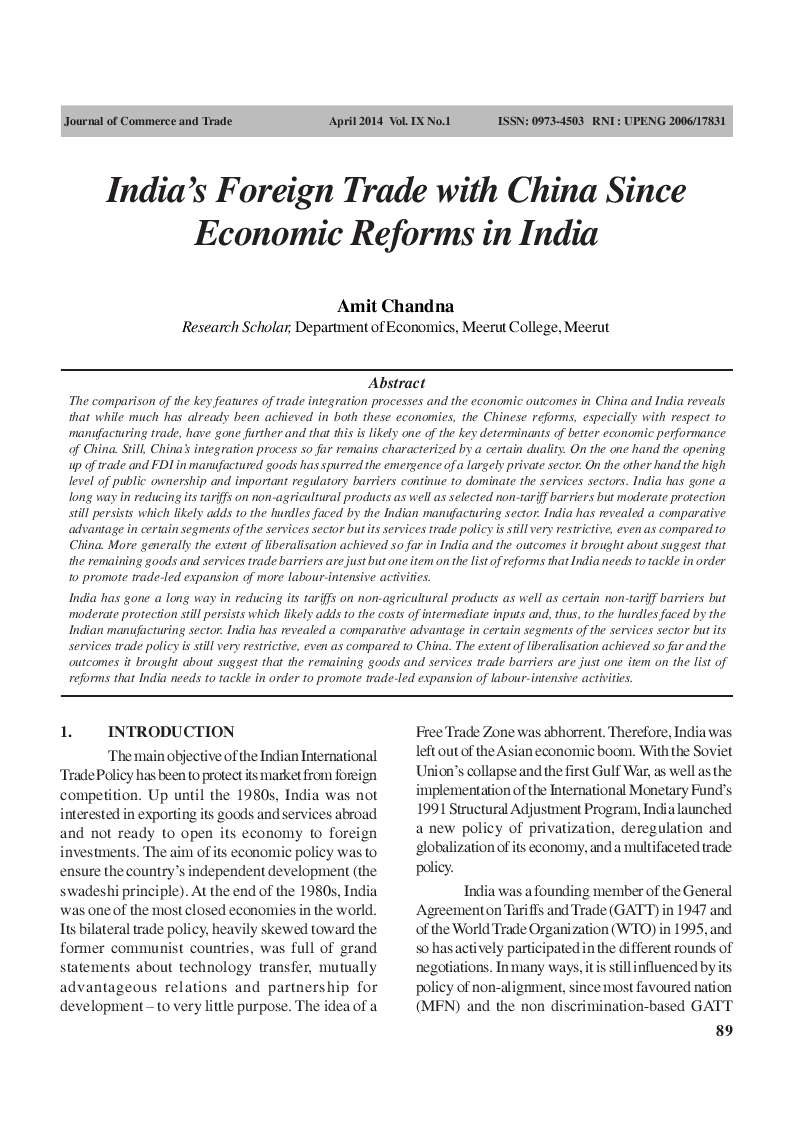India's Foreign Trade with China Since Economic Reforms in India
DOI:
https://doi.org/10.26703/jct.v9i1.156Keywords:
Foreign Trade, China, Economic Reforms, IndiaAbstract
The comparison of the key features of trade integration processes and the economic outcomes in China and India reveals that while much has already been achieved in both these economies, the Chinese reforms, especially with respect to manufacturing trade, have gone further and that this is likely one of the key determinants of better economic performance of China. Still, China’s integration process so far remains characterized by a certain duality. On the one hand the opening up of trade and FDI in manufactured goods has spurred the emergence of a largely private sector. On the other hand the high level of public ownership and important regulatory barriers continue to dominate the services sectors. India has gone a long way in reducing its tariffs on non-agricultural products as well as selected non-tariff barriers but moderate protection still persists which likely adds to the hurdles faced by the Indian manufacturing sector. India has revealed a comparative advantage in certain segments of the services sector but its services trade policy is still very restrictive, even as compared to China. More generally the extent of liberalisation achieved so far in India and the outcomes it brought about suggest that the remaining goods and services trade barriers are just but one item on the list of reforms that India needs to tackle in order to promote trade-led expansion of more labour-intensive activities.
Downloads
Metrics
References
Aksoy, M.A. and F.M. Ettori, (1992), Protection and Industrial Structure in India, Policy Research Working Paper Series No. 990, Washington, World Bank.
Banga, R, (2006), Statistical Overview of India’s Trade in Services: in Rupa Chanda (ed.), Trade in Services and India: Prospect and Strategies, p.p. 15-49, Centre for Trade and Development, Wiley-India, New Delhi.
Bhagwati, J. N. and Padma Desai (1970), “India: Planning for Industrialization”, Oxford University Press, Bombay.
Bhagwati J. (1962) “Indian Balance of Payments Policy and Exchange Auctions”, Oxford Economic Papers, February.
Chanda, R., (2005a), “Trade in Financial Services: India’s Opportunities and Constraints”, Working Paper No. 152, ICRIER, New Delhi.
Chanda, R., (2002), Globalization of Services: India’s Opportunities and Constraints, Oxford University Press, New Delhi.
Cohen, B (1964), “The Stagnation of Indian Exports, 1951-1961”, Quarterly Journal of Economics, November.
Eichengreen, B and P. Gupta (2010), Services Sector Growth: India’s Road to Economic Growth, ICRIER, Working Paper No: 249, New Delhi.
Garry Pursell, Nalin Kishor, and Kanu Priya Gupta (2007), Manufacturing Protection in India Since Independence, ASARC Working Paper 2007/07.
Gordon, J. and P Gupta, (2004), Understanding India’s Services Revolution, Working Paper No. WP/04/171, International Monetary Fund, Washington.
Trade. (n.d.). The American Heritage New Dictionary of Cultural Literacy, Third Edition. Retrieved June 13, 2014, from Dictionary.com website: http://dictionary.reference.com/browse/trade
Kusum Mundra (October 18, 2010). ”Immigrant Networks and U.S. Bilateral Trade: The Role of Immigrant Income”. papers.ssrn. Retrieved 2011-09-01. “Mundra, Kusum, Immigrant Networks and U.S. Bilateral Trade: The Role of Immigrant Income. IZA Discussion Paper No. 5237. Available at SSRN: http://ssrn.com/abstract =1693334 ”
Chawla, R. L. (2003), “India and WTO”, Indian Quarterly Journal of International Affairs, vol. 59, n° 3/4, p. 257.
Chakraborty, D. and Sengupta, D. (2006), IBSAC (India, Brazil, South Africa, China): A Potential Developing Country Coalition in WTO Negotiations, New Delhi, CHS, “CSH Occasional Paper”, n° 18, pp. 50 and 70.
Narasimhan, S. (2005), “India’s Look East Policy: Past, Present and Future”, in Reddy, K. R. India and ASEAN: Foreign Policy Dimensions for the 21st Century, New Delhi, New Century Publications, p. 32.
Saint-Mézard, I. (2003), “The Look East Policy: An Economic Perspective” in Grare, F. & Mattoo, A. Beyond the Rhetoric: the Economics of India’s Look East Policy, New Delhi, Manohar, pp. 25-27.
WT/TPRS/182, pp. 85 & 94-95.
WTO, Trade Policy Review: India, WT/TPR/S/100, 2002, § 24.
Ministry of External Affairs, India in Business, available on http://www.indiainbusiness.nic.in/investment/investment.
WTO, Trade Policy Review: India, WT/TPR/S/182, p. 34, 116-118, 142-144.

Additional Files
Published
How to Cite
Issue
Section
License
Copyright (c) 2014 Journal of Commerce and Trade

This work is licensed under a Creative Commons Attribution 4.0 International License.







